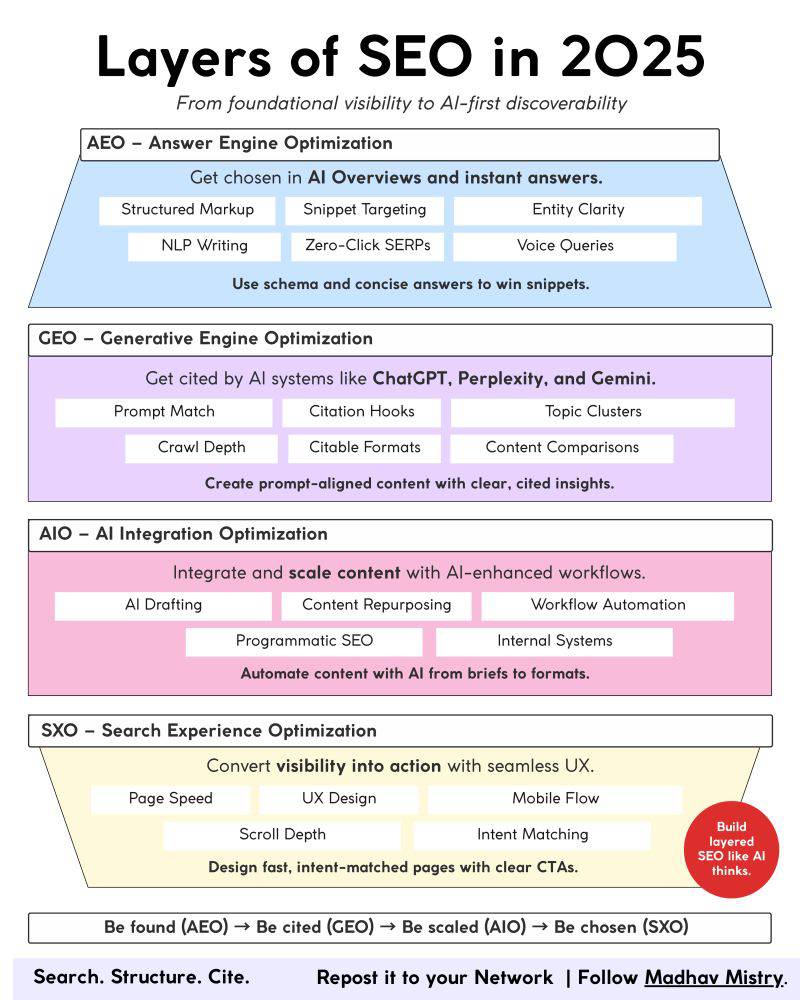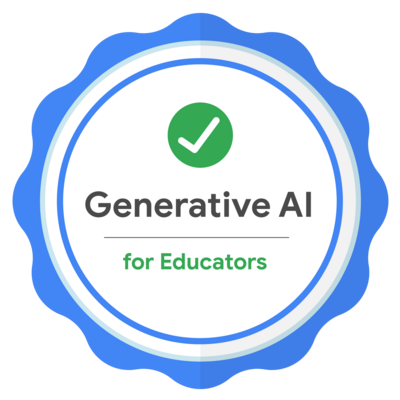Last Updated on August 24, 2025
SEO Meets AI: Your Essential Beginner’s Course
Target audience: Beginners with basic knowledge of traditional SEO who want to understand how AI is changing and enhancing SEO practices.
Course length: 5 modules, each 3 hours (total 15 hours)

Outcomes: By the end of this course, participants will be able to:
- Integrate AI meaningfully into SEO workflows
- Strategically create content for GEO and AI search
- Use tools effectively for analysis, planning, and optimization
- Realistically assess the opportunities and limitations of AI in SEO
Optional Extras:
- Prompt templates for SEO tasks
- Tool overview (free / paid)
- Sample data sets for keyword and content analysis
- Template for content chunking
- Final project (optional):
Participants create a mini SEO strategy in small groups for a sample site, including keyword planning, AI-generated content, chunking structure, and a GEO approach.
SEO in 2025 requires “Layered Visibility” across 4 systems:
- AEO (win AI overviews)
- GEO (get cited by ChatGPT/Perplexity)
- AIO (AI-powered workflows)
- and SXO (search-optimized UX)
Focus on being chosen by AI, not just ranking.

SEO Meets AI: Your Essential Beginner’s Course Module 1-5
Module 1: Understanding SEO in the AI Era
Goal:
Understand how AI is transforming SEO—from search behavior to content creation.
How AI is reshaping SEO? Actionable strategies to stay ahead of the curve:
What is AI SEO? How artificial intelligence is changing search optimization – searchengineland.com
Topics:
- What is AI? What is Generative AI?
AI simulates human thinking (e.g., chatbots). Generative AI creates new content (e.g., text, images).
Understanding how AI generates content helps SEOs craft prompts and structure inputs for tools like ChatGPT to streamline ideation, drafts, and optimization tasks.
Example: ChatGPT writes a blog post based on your keywords.
Feed AI tools structured keyword clusters and content briefs to generate SEO-aligned drafts that require less manual rewriting.
- How does Google SGE (Search Generative Experience) work?
Google shows AI-generated answers directly above search results.
To appear in SGE summaries, SEOs must focus on clarity, authority, and structured content that answers search intent directly.
Example: Instead of 10 links, you see an AI section with summaries.
Position your content as the “source” for AI summaries by using schema markup, AI content formatting, and first-party data.
- What is GEO and how is it different from traditional SEO?
GEO = Generative Engine Optimization — content is optimized for AI-generated answers, not just classic rankings.
GEO requires creating content that is concise, answer-focused, and semantically rich, making it easier for AI to extract and reuse.
Example: AI-friendly FAQs instead of just keyword-optimized paragraphs.
FAQs should use natural language questions and brief, high-quality answers, increasing the chance of inclusion in AI-generated summaries.
- Impact on content, keywords, and structure:
Content must be more precise, structured, and helpful — for both people and machines.
Use consistent H2/H3 formatting, bullet points, and question-answer formats to improve scannability for AI models and human readers.
Example: Clear H2 questions, short answers, clean formatting.
Build topical authority with clusters of related Q&A content — this improves your chances in both organic results and AI snapshots.
Practice:
- Analyze an SGE result using tools like ChatGPT
- Compare traditional articles to GEO-optimized ones (e.g., FAQ blocks, semantic structure)
- Understand how AI search and SEO connect
- Will AI Replace Search Engines? The Future of Search
Module 2: Keyword Research & Content Planning with AI
Goal:
Use AI to find relevant keywords and content ideas more quickly.
Topics:
Recognizing Long-Tail Keywords and Search Intent
Long-tail = specific queries with strong intent.
Example: “best hiking shoes for women with wide feet”
Semantic Analysis & Entity Mapping
Move from keywords to entities and their relationships. Tools like Surfer and AI EngineBoost map meanings and clusters.
Example: Target “Digital Marketing” → cluster with SEO, Analytics, Certification.
Intent Prediction & User Journey Mapping
AI helps detect user intent and journey stages (informational, transactional, navigational).
Example: “What does a digital marketer do?” (informational) vs. “Best online digital marketing course Berlin” (transactional)
Prompts for Keyword Clustering
Use structured prompts to generate topic clusters.
Example: “Create keyword clusters for vegan nutrition”
https://seo.ai/blog/chatgpt-prompts-for-seo
Long-Tail Discovery with AI Patterns
Structured prompts generate more long-tail queries than traditional tools.
Example: From “online course” → “best free online course for working moms in marketing”
Multilingual Keyword Research Automation
AI uses embeddings to uncover aligned queries in other languages.
Example: “SEO für Anfänger” → “SEO for Beginners,” “Google for Newbies”
Query Clustering and Topic Modeling
Neural clustering turns similar searches into content clusters.
Example: “Is SEO hard?” + “SEO roadmap” = a content hub on learning SEO
Why This Matters in 2025
- Entity-based overviews dominate
- AI predicts future queries
- SEO = answer readiness
Strategy Summary
| Strategy | Why It Matters | AI Advantage |
|---|---|---|
| Entity Mapping | Aligns with semantic understanding | Embeddings reveal hidden relationships |
| Intent Prediction | Aligns content with user journey | AI classifies and targets more accurately |
| Long-tail Discovery | Captures unique, conversational queries | AI spots patterns humans may miss |
| Multilingual Research | Expands reach with less manual effort | AI translates intent, not just language |
| Query Clustering | Builds topical authority and structure | AI models group semantically related content |
Practice:
- Create topic clusters with AI (e.g., “coffee brewing” → filter coffee, espresso, cold brew)
- Competitor analysis: What keywords and formats are they using?
- Use Semrush/Sistrix to find keywords triggering AI Overviews and design content to answer them
- 8 AWESOME SEO AI Tools That Absolutely Love Using
Module 3: Content Creation & Chunking with AI
Goal:
Create structured, AI-friendly content. Create chunks!
Topics:
- Prompts for content briefings and outlines
Example prompt: “Write a briefing for an article about remote work tips.” - Chunking strategies
Content is divided into meaningful sections.
Examples: FAQ, how-to steps, checklists. - Meta titles, descriptions, and headlines with AI
Example: ChatGPT generates 5 versions of an engaging meta title.
Practice:
- Structure an article (H2s, paragraphs, lists)
- Test snippet variants: “What’s a good meta title for this content?”
- Why Content Chunking For Ranking AI Overviews Makes Sense
Module 4: Analysis, Auditing & Automation with AI
Goal:
Analyze and improve content and automate SEO processes.
Topics:
- Content audit with AI
AI identifies outdated content, gaps, repetitions.
Example: “What’s missing on my nutrition page?” - Forecast performance and ranking chances
AI can estimate if a text has ranking potential.
Example: “What’s the ranking potential of this blog post?” - Tools for analysis:
- Screaming Frog for technical checks
- Google Search Console + ChatGPT for interpretation
- SEO tools from SEO.com
Practice:
- Review a blog post: quality, structure, value
- Apply AI suggestions: new title, better meta description
Module 5: Ethics, Law & Future Outlook
Goal:
Use AI-SEO responsibly and with future-readiness.
Shaping the Future of Search Engine Optimization
Topics:
- EU AI Act: What businesses need to know
- Copyright & labeling requirements
AI-generated texts can pose legal issues.
Example: Who is the author of AI-generated content? - Transparency, fairness, bias
AI can reflect biases — critical content review is necessary.
Example: “Are the facts balanced and inclusive?” - Future-proof SEO
Stay flexible: search engines evolve.
Example: Focus on helpful content, not just keywords. - Tools & trends:
Voice search, multimodal AI, real-time answers
Practice:
- Discussion: What stays human, what’s taken over by AI?
- Create an AI-SEO checklist: ethical, legal, strategic
- Voice Search: How to optimize for voice and local queries

AI & SEO Work Better Together
Want more practical tips for combining AI and SEO to create content that serves your audience and boosts search rankings? AI supports you, it doesn’t replace you. https://warrenlainenaida.net/beyond-algorithms-using-ai-to-enhance-audience-first-seo
Here’s a breakdown of basic SEO tasks and how AI supports them:
Keywords
Basic tasks:
- Use tools like Sistrix, SEMrush, Ahrefs for keyword research
- Analyze intent behind target keywords
- Map keywords to specific pages/content
- Track keyword rankings and performance
- Identify long-tail keyword opportunities
- Monitor competitor strategies
AI applications:
- Generate keyword variations and semantic alternatives
- Analyze intent patterns across large keyword sets
- Automate keyword difficulty scoring
- Create content briefs from top-ranking pages
- Predict trend keywords and search behavior
Local SEO
Basic tasks:
- Claim and optimize Google Business Profile and Bing Places with accurate NAP (Name, Address, Phone)
- List businesses in directories (e.g., Yelp, Yellow Pages)
- Generate and manage customer reviews
- Create local landing pages for multiple locations
- Optimize for “near me” searches and local keywords
- Build local backlinks
AI applications:
- Automate listings and check NAP consistency
- Generate localized content variations
- Monitor and respond to reviews at scale
- Analyze local trends and competitor strategies
- Generate local keyword variations and clusters
On-Page SEO
Basic tasks:
- Optimize title tags and meta descriptions
- Structure content with proper heading hierarchy (H1–H6)
- Optimize images with alt text and filenames
- Improve internal linking structure
- Ensure clean URL structure and breadcrumbs
- Improve page speed and UX signals
AI applications:
- Generate optimized titles and descriptions at scale
- Identify content gaps and suggest improvements
- Automate internal linking suggestions
- Create schema markup
- Generate image alt text
- Optimize content for featured snippets and voice search
Off-Page SEO
Basic tasks:
- Build high-quality backlinks via outreach
- Create shareable content to attract natural links
- Guest post on relevant sites
- Monitor and disavow toxic backlinks
- Build brand mentions and citations
- Use social media to amplify content
AI applications:
- Identify link-building opportunities
- Personalize outreach emails at scale
- Analyze competitor backlink profiles
- Monitor brand mentions online
- Generate linkable content ideas
- Automate backlink quality scoring
Technical SEO
Basic tasks:
- Ensure proper crawling and indexing
- Optimize site speed and Core Web Vitals
- Implement SSL and HTTPS
- Create and submit XML sitemaps
- Fix broken links and redirects
- Optimize for mobile responsiveness
- Implement structured data
AI applications:
- Automate technical audits and issue detection
- Generate structured data markup
- Analyze logs for crawl optimization
- Predict and prevent technical issues
- Optimize server response times
- Automate redirects for migrations
eCommerce SEO
Basic tasks:
- Optimize product pages with unique descriptions/specs
- Implement product schema for rich snippets
- Optimize category and collection pages
- Handle duplicate content for similar items
- Optimize for shopping/product search
- Use user-generated content (e.g., reviews)
- Create comparison and buyer’s guide content
AI applications:
- Generate unique product descriptions at scale
- Create product comparison content automatically
- Optimize product images and alt text
- Personalize product recommendations
- Analyze search trends for inventory/content planning
- Generate FAQs from customer questions
- Automate product feed optimization for Google Shopping
Are You Interested in this Course?
Please Contact Me

Generative AI for Educators Certificate Abgeschlossen von Warren Laine-Naida am 29. Oktober 2024
This certificate verifies that the learner listed has successfully completed the two-hour Generative AI for Educators course.
- Ergebnis: 92
- Fertigstellungs-ID: 343052094